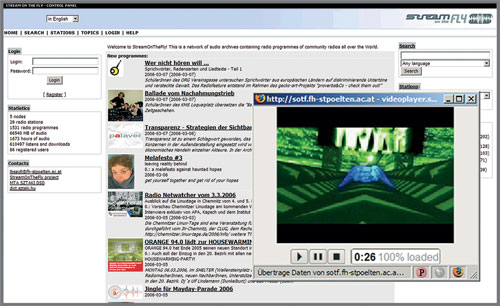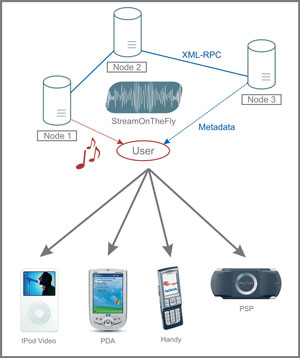
ERCIM News 66July 2006Special theme: European Digital Library Contents This issue in pdf Subscription Archive: Next issue: October 2006 Next Special theme: |

by László Kovács, András Micsik, Martin Schmidt and Markus Seidl
The StreamOnTheFly network combines peer-to-peer networking and open-archive principles for community radio channels and TV stations in Europe. StreamOnTheFly demonstrates new methods of archive management and personalization technologies for both audio and video. It also provides a collaboration platform for community purposes that suits the flexible activity patterns of these kinds of broadcaster communities.
Community broadcasters are non-profit, are open to the general public and have a local or regional scope. They provide access to radio and TV production facilities for organizations, groups and individuals aiming to make their own programs or shows. Community radio stations and TV channels would like to be able to archive, exchange and stream content over the Internet, but appropriate tools are not yet available at an affordable price. They have therefore expressed a desire to set up a robust distributed infrastructure with a technological solution that is flexible, effective and low-cost.
In 2002, the StreamOnTheFly project with the participation of Public Voice Lab (Austria), SZTAKI and Team Teichenberg (Austria) obtained grants from the European Commission's IST Programme to build a middleware application for radio with various front ends. StreamOnTheFly was focused on next-generation audio content management and broadcasting offering a customizable community radio program. It is now able to demonstrate new methods of management and personalization technologies for both audio and video. It also provides a collaboration platform that suits the flexible activity patterns of local broadcaster communities.
In a time when access to broadband Internet and the demand for online video material are rapidly increasing, video compatibility has become an important criterion for online media archives. With this in mind, the development of the video extension was initiated in January 2006 by a group of developers at the University of Applied Sciences St. Pölten.
In the case of video, an emphasis was placed on compatibility with a wide variety of user devices, such as mobile phones, iPods, PDAs and Sony's Playstation Portable. The realization of this goal was achieved with the help of ffmpeg, the leading open-source video transcoding tool. Another enhancement of the archive was the adaptation of StreamOnTheFly's RSS (Really Simple Syndication) functionality to make video podcasting an integrated part of the archive.
StreamOnTheFly Architecture
The original StreamOnTheFly architecture consisted of three main components:
The core of the StreamOnTheFly network combines peer-to-peer networking and open-archive principles, while other services are realized as separate network components communicating through open interfaces (APIs). There is no central server in the network, and metadata is exchanged in a peer-to-peer manner. The content is stored on the node of the publisher while all content metadata is available on all node servers. This enables fast searching and browsing with reasonable storage requirements.
 |
| Figure 1: StreamOnTheFly Node Server Interface. |
A simple exchange format called XBMF (Exchange Broadcast Binary and Metadata Format) is a core element of the network. XBMF enforces the coupling of metadata with content, and also creates the possibility of providing content in different audio formats, or attaching different media (eg images, text) to the audio content.
During the evolution of the StreamOnTheFly network the node server component (archive) remained in focus, while the other two components (station control, portal) were made replaceable using standard communications. A plug-in for free, professional, radio station management software is under development: this will support the archiving of programmes on node servers. RSS 2.0 or OAI-PMH (Open Archives Initiative - Protocol for Metadata Harvesting) are used to promote archived content to portal engines (eg Typo3, Manila, Plone) and search engines. Via podcasting, selected content can be easily transferred to PDAs, iPods and other handheld devices.
 |
| Figure 2: StreamOnTheFly Network Protocols and Access Methods. |
StreamOnTheFly in Operation
The StreamOnTheFly network is operational since October 2003. The core of the network (five network nodes are up currently) is accessible in four languages (English, German, French and Hungarian), and contains more than 1800 hours of audio content stored in 1700 programmes (http://radio. sztaki.hu). Other applications of the software include an exhibition, school and fair radios, e-learning and linguistic projects. The StreamOnTheFly software suite is open-source and licensed under the GNU General Public License.
Although the StreamOnTheFly project officially finished in June 2004, voluntary work is continuing to implement various extensions and use cases. Since that time StreamOnTheFly has proved its flexibility and extensibility in several cases. The architectural decisions made in StreamOnTheFly justified themselves as an open and scaleable base for further developments.
Links:
Project home page: http://www.streamonthefly.org
The Hungarian node: http://radio.sztaki.hu
Please contact:
László Kovács, SZTAKI, Hungary
Tel: +36 1 279 6212
E-mail: laszlo.kovacs![]() sztaki.hu
sztaki.hu
Markus Seidl, University of Applied Sciences St. Pölten, Austria
Tel: +43 2742 313 228 - 245
E-mail: markus.seidl![]() fh-stpoelten.ac.at
fh-stpoelten.ac.at